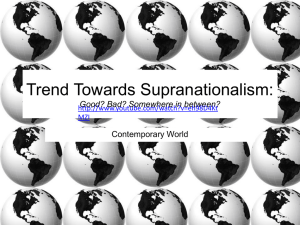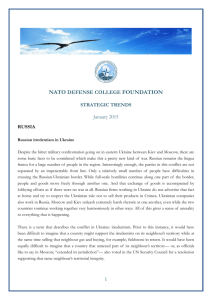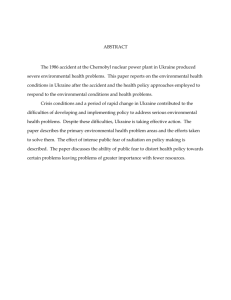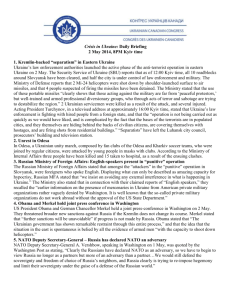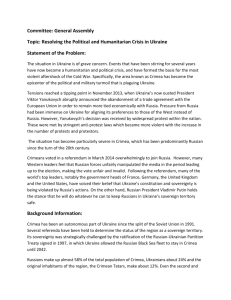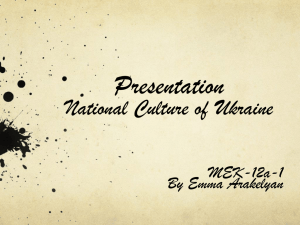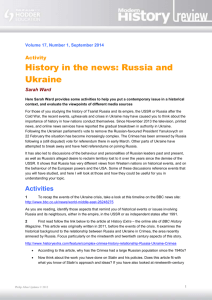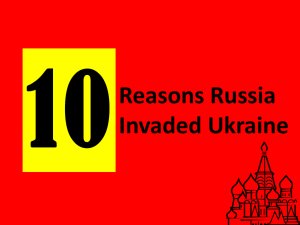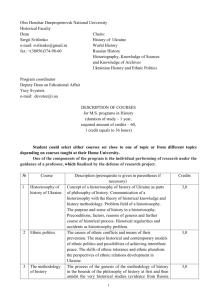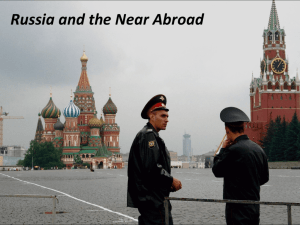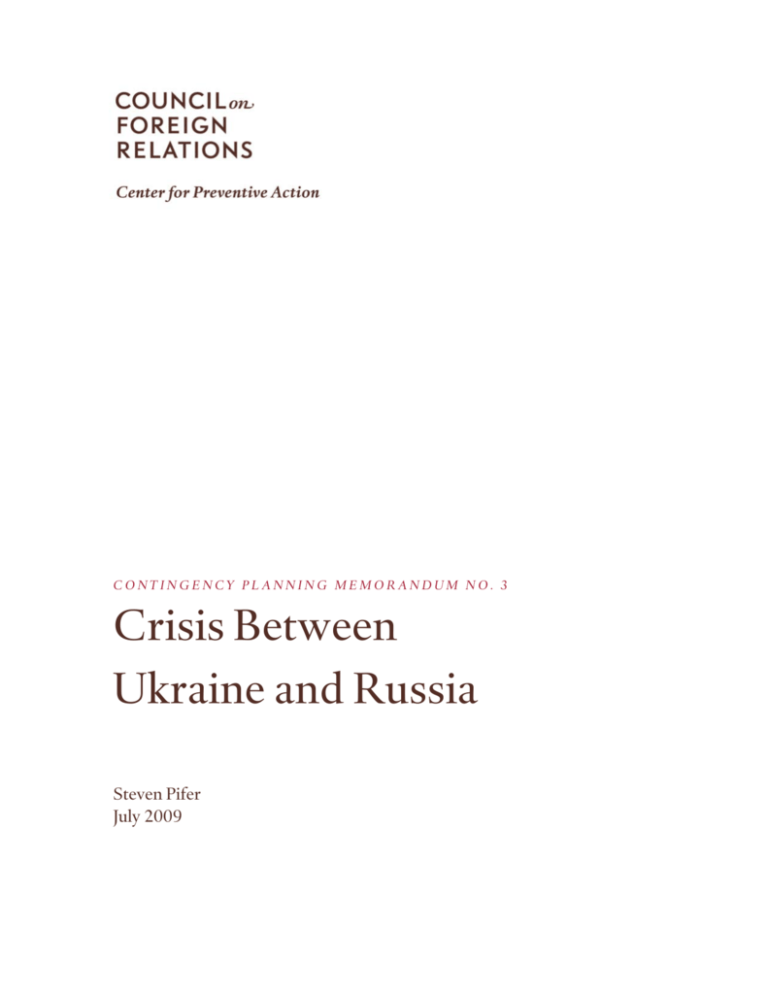
CONTINGENCY PLANNING MEMORANDUM NO. 3
Crisis Between
Ukraine and Russia
Steven Pifer
July 2009
The Council on Foreign Relations (CFR) is an independent, nonpartisan membership organization, think
tank, and publisher dedicated to being a resource for its members, government officials, business executives, journalists, educators and students, civic and religious leaders, and other interested citizens in order
to help them better understand the world and the foreign policy choices facing the United States and other
countries. Founded in 1921, CFR carries out its mission by maintaining a diverse membership, with special programs to promote interest and develop expertise in the next generation of foreign policy leaders;
convening meetings at its headquarters in New York and in Washington, DC, and other cities where senior government officials, members of Congress, global leaders, and prominent thinkers come together
with CFR members to discuss and debate major international issues; supporting a Studies Program that
fosters independent research, enabling CFR scholars to produce articles, reports, and books and hold
roundtables that analyze foreign policy issues and make concrete policy recommendations; publishing
Foreign Affairs, the preeminent journal on international affairs and U.S. foreign policy; sponsoring Independent Task Forces that produce reports with both findings and policy prescriptions on the most important foreign policy topics; and providing up-to-date information and analysis about world events and
American foreign policy on its website, CFR.org.
The Council on Foreign Relations takes no institutional position on policy issues and has no affiliation
with the U.S. government. All statements of fact and expressions of opinion contained in its publications
are the sole responsibility of the author or authors.
The Center for Preventive Action (CPA) Contingency Roundtable series seeks to organize focused discussions on plausible short to medium term contingencies that could seriously threaten U.S. interests.
Contingency meeting topics range from specific states or regions of concern to more thematic issues and
draw on the expertise of government and nongovernment experts. The goal of the meeting series is not
only to raise awareness of U.S. government officials and the expert community to potential crises but also
to generate practical policy options to lessen the likelihood of the contingency and to reduce the negative
consequences should it occur. A summary memo of the resulting recommendations is distributed to participants and important policymakers.
For further information about CFR or this paper, please write to the Council on Foreign Relations, 58
East 68th Street, New York, NY 10065, or call Communications at 212.434.9888. Visit CFR’s website,
www.cfr.org.
Copyright © 2009 by the Council on Foreign Relations®, Inc.
All rights reserved.
Printed in the United States of America.
This paper may not be reproduced in whole or in part, in any form beyond the reproduction permitted by
Sections 107 and 108 of the U.S. Copyright Law Act (17 U.S.C. Sections 107 and 108) and excerpts by
reviewers for the public press, without express written permission from the Council on Foreign Relations.
For information, write to the Publications Office, Council on Foreign Relations, 58 East 68th Street, New
York, NY 10065.
1
INTRODUCTION
Continuing political turmoil in Ukraine and tense relations between Kiev and Moscow have increased the potential for Ukraine to tumble into crisis with Russia. The crisis scenarios of greatest
concern over the next six to twelve months are a major confrontation between Ukraine and Russia in
Crimea and, more likely, a new dispute over the supply of Russian natural gas to Ukraine. This contingency planning memorandum does not predict such crises occurring. Rather, it examines how
they might plausibly be triggered, the implications for the United States should they occur, and the
steps the U.S. government might take to reduce the prospects of a crisis and, should it occur, to manage it.
POSSIBLE CRISIS SCENARIOS
The dominant factor in Ukrainian political life during the past four years has been the inability of
President Victor Yushchenko and his prime ministers—with the exception of Yuriy Yekhanurov’s
brief term—to work together to promote coherent executive branch policy. Clashes with Yulia Tymoshenko and Victor Yanukovych during their tenures as prime minister are a major reason why
Ukraine has moved so slowly and haltingly to fulfill its potential in the aftermath of the 2004 Orange
Revolution. Following the collapse of efforts between current Prime Minister Tymoshenko and opposition leader Yanukovych to produce a new rada (parliament) coalition and implement constitutional amendments, Ukraine will increasingly become absorbed with a presidential election campaign this autumn.
Ukraine’s relations with Russia remain troubled by disputes over the supply of natural gas, Yushchenko’s desire to integrate Ukraine into NATO, arguments over the Russian Black Sea Fleet (BSF),
and other difficulties. The Russian leadership has kept up a steady barrage of criticism directed at
Kiev. At the same time, important European countries have become hesitant in their engagement of
Ukraine. While the European Union has included Ukraine in its Eastern Partnership policy, Kiev remains frustrated with the EU’s continued reluctance to offer Ukraine the prospect of future membership. As for the United States, Ukrainians worry that the effort to “reset” relations with Russia will
come at their expense.
Against this difficult backdrop, several scenarios could generate crises in Ukraine. This paper
looks at those scenarios that are most plausible and that would be of consequence to U.S. interests.
Major Ukrainian-Russian Confrontation over Crimea
Several scenarios could generate a crisis between Kiev and Moscow in Crimea, which would have
significant consequences for U.S. interests. Were conflict to break out again between Russia and
Georgia, and Sevastopol-based BSF warships were to sortie and operate off the Georgian coast,
Yushchenko might decree that those ships would not be allowed to return, as he did in August 2008.
He could take the further step of ordering the Ukrainian navy to close Sevastopol harbor, setting a
possible confrontation between Russian and Ukrainian warships.
Other scenarios that might generate a crisis in Crimea include an escalating dispute regarding the
terms and duration of the BSF presence in Crimea and Russian unhappiness with a late Yushchenko
2
effort to push relations with NATO. Also, any demonstration (pro-BSF or anti-NATO) could trigger
a crisis with Russia if demonstrators were to be injured in a clash with Ukrainian security forces and
the Russians decided to use that as a pretext for intervention. Moscow might choose to deploy BSF
naval infantry to “protect” its Russian “compatriots.” As a result of inattention to Crimean Tatar issues by the Ukrainian government and a change of approach from Russia, which now appears to be
courting Crimean Tatar support, a Crimean crisis could play out among three ethnic groups.
These scenarios could lead to a situation in which Ukrainian and Russian warships, or Ukrainian
internal security forces and BSF naval infantry, faced off. Although neither government might want
it, shots could be exchanged and trigger a full-scale crisis.
New Ukraine-Russia Dispute over Natural Gas Supply
This is the most likely crisis scenario. Although the January multi-year gas contract puts the Ukrainian-Russian gas relationship on a more solid foundation than in the past (when one-year contracts
expired on December 31), the contract still has vulnerabilities. Ukraine has been in technical default
since February, when it failed to purchase the minimum quantity of gas it had contracted to buy. (The
contract requires Ukraine to pay for the minimum amount of gas contracted for, whether it takes it or
not; although Prime Minister Vladimir Putin has said that Russia will not seek to collect the debt for
gas that was not bought, Gazprom has not agreed to modify the contract.)
Putin and other Russians regularly question Ukraine’s ability to pay and to maintain the reliability
of the gas pipelines through which 80 percent of Russian gas bound for Europe is transported. Moscow also charges that Ukraine is not buying gas to fill the reservoirs in western Ukraine; these are
typically filled in summer months so that gas may be drawn from them in the winter to send to Europe.
Either side could trigger a new gas war. Given the impact of the economic crisis, the loss of gas
sales and the associated revenues would concern Moscow. Whether they would deter Moscow from
provoking a gas crisis is unclear. They would presumably affect Russian desires to end the crisis—on
Moscow’s terms—before too much revenue was lost. This could mean that Russia would escalate the
crisis to press Kiev to back down.
Continued Political Infighting Leads to Continued Political Stalemate
The June 7 collapse of the effort between Tymoshenko and Yanukovych and their parties, the Bloc of
Yulia Tymoshenko and the Party of Regions, to form a broad coalition and amend the constitution
has refocused the country on the upcoming presidential election. The election does not guarantee a
more effective or coherent government. Ukraine’s complicated political relations could remain stalemated.
The significance of such a situation, however, should not be exaggerated. Ukrainians have learned
to live with “political crisis” over the past four years. It is by no means good for the country; Ukraine
forgoes policies that would help it develop into a modern European democracy and draw closer to
Europe. But Ukrainians have become used to this and, when the situation threatens to boil over—as
it did in summer 2006 and spring 2007—the important players draw back and find a compromise
that at least lowers the temperature.
3
Economic Downturn Leads to Political and Social Unrest
The Ukrainian economy has contracted significantly since last fall. Yushchenko in May said that the
gross domestic product (GDP) had fallen by 20 percent in 2009, on top of a major contraction during
the last three months of 2008. Some analysts expressed concern at the beginning of 2009 that this
downturn, with particularly severe effects on heavy industries in eastern Ukraine, might cause political or social unrest.
Nine months into the economic crash, however, there have been small protests but no wide-scale
unrest, and some economists assert that the Ukrainian economy may soon bottom out. Ukrainians
appear ready to tolerate depressed economic circumstances; there is little reason at present to expect
major political or social unrest.
The remainder of this paper will focus on the first two crisis scenarios: major Ukrainian-Russian
confrontation in Crimea and a new Ukraine-Russia gas war.
MAJOR UKRAINIAN-RUSSIAN CONFRONTATION IN CRIMEA
Likelihood over Next Six to Twelve Months
The likelihood of a major crisis in Crimea is small but still plausible. There would have been one in
August 2008 had the Ukrainian navy deployed to enforce Yushchenko’s decree that BSF warships
which had participated in operations off Georgia not be allowed to return to Sevastopol. The likelihood of the crisis probably diminishes as the end of Yushchenko’s term approaches. Polls indicate that
Yushchenko has virtually no chance of winning reelection. Regardless of whether the next president
is Tymoshenko, Yanukovych, or former rada speaker Arseniy Yatseniuk, Ukraine is likely to pursue a
more modest pace in developing its relations with NATO, a more measured tone on support for
Georgia, and more moderate relations with Russia. That presumably would lower Moscow’s interest
in any crisis regarding Crimea.
Warning Indicators
Several actions could signal increased prospects for a major confrontation in Crimea. These include
renewed Russian-Georgian conflict with the participation of Sevastopol-based BSF warships, a big
push by the outgoing president to launch negotiations on the BSF’s ultimate withdrawal, an upsurge
in issuance of Russian passports in Crimea, and a general escalation in Ukrainian-Russian tensions.
Demonstrations in Sevastopol or elsewhere in Crimea also would raise the prospects, given the possibility of a clash (even if unintended) with Ukrainian internal security forces.
The Russian government presumably would not want to be seen as being responsible for generating a crisis in Crimea. Should a crisis develop, U.S. policymakers should closely consider the circumstances, including whether Moscow provoked it using surrogates, such as pro-Russian civil society
groups or local media on the peninsula.
4
Possible Consequences
A major confrontation in Crimea, if badly mishandled, could lead to an exchange of fire between
Ukrainian and Russian warships or land forces in or near Sevastopol. At that point, the crisis would
likely escalate, though Kiev and Moscow presumably would work to prevent major hostilities. The
Kremlin, however, could begin a focused effort to destabilize the Ukrainian government and/or undermine Ukrainian sovereignty over Crimea. In the worst—and most unlikely—case, it might even
instigate or support an effort by Crimea to break away from Ukraine.
Specific consequences of such a crisis for the United States would include:
– Kiev would appeal to Washington under the 1994 Budapest memorandum on security assurances,
citing Russia’s threat to Ukrainian sovereignty and territorial integrity.
– Some NATO allies would demand that the Alliance take actions to support Ukraine.
– Washington would be pressed to reassure certain NATO allies. In particular, those on or near
Russia’s borders would cite the Russian threat and push for more tangible signs of U.S. commitment to defend them from Russia, such as deployment of U.S. Patriot anti-aircraft batteries or
other units on their territories.
– Ukraine and NATO/EU states would follow the U.S. reaction to gauge the strength of Washington’s commitment to Ukraine (and to European security). A weak reaction could undermine U.S.
credibility.
– Other NATO allies would question the wisdom of close alliance relations with a Ukraine in crisis
with Russia, likely dividing NATO and the West in their response.
– Pursuit of a “reset” in U.S.-Russian relations would become politically untenable in Washington if
Russia were seen as provoking the crisis and/or unwilling to resolve it.
U.S. Policy Options to Prevent the Crisis
U.S. officials should caution Kiev on choosing its disputes carefully with Moscow. For example, confronting Moscow with a demand to open negotiations on BSF withdrawal should await a more stable
political situation in the Ukrainian government. Washington must also ensure that Kiev has a clear
understanding of how much support it can expect from the United States should it end up in a major
confrontation with Russia. While Yushchenko is a more cautious leader than Georgian president
Mikheil Saakashvili, he needs to understand the limits of American support so that there is no miscalculation.
Russian misbehavior in Ukraine, particularly Moscow-inspired efforts to weaken Kiev’s sovereignty over Crimea, would undoubtedly set back, if not end, efforts to “reset” U.S.-Russian relations.
U.S. officials may want to look for opportunities to quietly make this point to their Russian counterparts. The more successful the administration is at broadening the U.S.-Russian relationship—such
as if there is progress toward a post-Strategic Arms Reduction Treaty (START) agreement or indications of greater flexibility on U.S. plans for missile defense in Central Europe—the more that relationship may serve to discourage Russia from negative actions in Ukraine. The impact of this should
not be overestimated, but Washington should seek to shape a relationship in which Kremlin interest
5
in the gains from better relations with Washington can create a restraining factor on Russian policies
regarding Ukraine.
Washington should consult closely with its European allies to encourage them to send similar
messages to Kiev and Moscow. It would reinforce the message if the West could articulate credible
costs that Russian action to undermine Ukrainian sovereignty over Crimea would entail. Defining
such costs with the European Union will not be easy.
The U.S. government and its European partners should establish a greater presence in Crimea, including the U.S. plan to open an American presence post in Simferopol, expanded people-to-people
exchanges, and support for Western nongovernmental organization projects on the peninsula.
U.S. Policy Options to Manage the Crisis
Should a major confrontation between Kiev and Moscow erupt in Crimea, with Russia the instigator,
the fundamental U.S. goals would be to prevent further escalation and bring the crisis to a swift conclusion without compromising Ukraine’s sovereignty and territorial integrity. Washington would
also want to manage the crisis in a manner that maintained solidarity with Europe and did not undermine the confidence of NATO allies in U.S. security commitments.
The Ukrainian government can be expected to invoke the Budapest memorandum, seeking at minimum consultations with and political support from Washington. The administration would doubtless come under tremendous pressure from some quarters—in Congress and the media––to show
solidarity with Ukraine and “get tough on Russia.” A coercive strategy designed to accomplish these
goals could conceivably draw upon the following range of options:
– Immediate public and private remonstrations by senior U.S. officials to signal U.S. displeasure as
well as the suspension of some specific U.S.-Russian bilateral activities.
– A concerted diplomatic offensive at the UN Security Council, European Union, NATO, and
OSCE to support Ukrainian territorial integrity and sovereignty over Crimea and condemn any
Russian action to undermine it. Washington might urge EU members to freeze relations with
Russia until the crisis is resolved and NATO to suspend all ongoing or planned military-tomilitary activities. China and various post-Soviet states, which would be nervous about another
Russian challenge to post-Soviet borders following the 2008 conflict between Russia and Georgia, should also be engaged diplomatically to pressure Russia.
– Economic and financial-related penalties, including withholding support for Russian accession to
the World Trade Organization (WTO) and Organization for Economic Cooperation and Development, working with the European Union to limit U.S. and EU commercial dealings with Russia,
particularly by its banks and large business enterprises, and more generally seeking to undermine
private investor confidence by declaring Russia to be an unstable and risky marketplace.
– Military/security-related actions, including deploying U.S. naval ships to the Black Sea to signal
support for Ukraine and high-profile visits by U.S. defense officials to the capitals of NATO countries. Washington might also consider military sales to NATO allies in the area. The deployment of
Patriot antiaircraft batteries or other U.S. units to those countries to reassure allies and demonstrate resolve are also options.
6
It is not certain, however, whether employment of all of these options would achieve the desired
effect. It may even prove counterproductive. Certain diplomatic restrictions could harden the Russian position and reduce avenues for negotiation. Economic sanctions by the United States alone are
unlikely to have much impact. U.S. trade with Russia is relatively small. Putin also recently indicated
that Russian accession to the WTO is not a priority but that Russia will seek to join in a customs union with Kazakstan and Belarus. And military deployments close to Ukraine and Russia are likely to
be matched and raised by Russia. Besides the latent risk of dangerous interactions with Russian military forces, starting up the ladder of further military deployments makes little sense for the United
States if in the end it will back down.
All this suggests that a more calibrated and graduated policy response would be preferable. This
would include many of the same options but not necessarily as an immediate response to Russian
behavior. Much would depend of course on the nature of Russia’s transgressions. A diplomatic strategy to isolate Russia and pressure it to reverse course would still be pursued. This would include diplomatic protests and multilateral condemnation. At the United Nations, Russia would undoubtedly
veto any UN Security Council resolution, but striving to put it in a position where it stands alone
would still be worthwhile. China would not be comfortable supporting a Russian veto or with any
implication that Beijing supported the unilateral re-drawing of national borders. Similarly, NATO
should be used as a venue to condemn Russia’s actions, but the NATO-Russia Council should not be
suspended; it instead should be used as a mechanism to condemn Russian actions. While working
with the European Union to pressure Russia, Washington should encourage EU officials to offer to
mediate the crisis (some mediator will be necessary, and Moscow is unlikely to accept the United
States in that role). Initial preparations to impose a variety of U.S. and EU economic and financial
sanctions could nevertheless be set in motion, with their probable trajectory made abundantly clear
to Moscow.
NEW UKRAINE-RUSSIA GAS WAR
Likelihood Over Next Six to Twelve Months
Although the Ukrainian-Russian contract ending the January gas war puts energy relations between
those two countries on a stronger basis than in the past, the contract still contains vulnerabilities that
could lead to a breakdown. Ukraine already is in technical default as it has failed to buy the minimum
amounts of gas that it had contracted to buy.
Russian rhetoric about Ukraine’s inability to pay and Ukraine’s general reliability as a gas transit
state has been loud, with a growing stridency after the March 23, 2009, EU-Ukraine declaration on
gas transit, which infuriated senior Russian officials. Some analysts project that a new gas spat could
break out this summer; others think it might be timed to influence the Ukrainian presidential election
or occur in the winter, when Moscow may assume that cold weather gives it greater leverage.
China has resisted Russia’s efforts to get their recognition of Abhazia and South Ossetia.
7
Warning Indicators
Several developments could indicate an impending gas crisis. Rising Russian rhetoric and Ukrainian
failure to pay for gas could signal greater likelihood of a coming spat. Western observers might watch
for Gazprom actions similar to those last December when it tried to preposition itself to win the public relations battle over the cut-off, as well as monitoring the flow of gas to Ukraine’s reservoirs and
Kiev’s ability to pay its gas bills. Growing disputes between Kiev and Moscow over other issues
might spill over into the gas relationship.
Potential Consequences
The direct potential consequences on the United States of another gas war would be relatively modest. The economic and other pain inflicted on Ukraine and NATO/EU states such as Bulgaria, Romania, and Slovakia would depend on the timing of the crisis. A gas cut-off in summer or early autumn
would be far easier to weather than in January.
Another gas war would test EU solidarity to the extent that EU states were prepared (or not prepared) to work together. Differing dependencies on Russian gas within the European Union mean
that the impact would fall unevenly: last January, while apartments in Bulgaria and Romania froze,
the gas cut-off had little discernible impact in Germany, France, or most other EU states in Western
Europe. Another gas war would highlight the lack of a common EU energy policy and common EU
energy market.
To the extent that Ukraine was seen as responsible for the gas cut-off, EU unhappiness with Kiev
would grow, as would support for pipelines—Nord Stream, South Stream, and Blue Stream II—
circumventing Ukraine. Empathy for Kiev in European capitals would decline, and its road to draw
closer to the European Union would become more difficult.
U.S. Policy Options to Prevent the Crisis
Washington should urge Kiev to get its energy house in order. This means taking the tough decisions
to raise domestic prices for energy to at least cost-recovery levels so that Naftohaz can become an
economically viable entity. That said, successive Ukrainian governments have paid little attention to
U.S. and European entreaties along this line for the past ten years; there is little reason to expect action in the run-up to Ukraine’s presidential election. The United States and Europe should consult on
ways to press Ukraine to address energy reform in a serious manner, perhaps by making such reform
a condition for Western support for new international financial institution lending to Ukraine.
Washington should also consult with the European Union on how it plans to cope with a new gas
cut-off, such as transconnector pipelines that would allow western EU members to send gas to countries such as Romania and Bulgaria that are at greater risk in the event of a cut-off. The U.S. government might also consider a stronger push in support of the Nabucco gas pipeline. While not a shortterm solution, it would in the longer term provide a hedge against a new Russian gas cut-off.
Finally, Washington should consider the merits of joining with EU countries and international financial institutions to provide additional financing that might help Ukraine meet its budget deficit
and perhaps cover some gas expenditures. But the U.S. government should insist—and condition
financing—on real steps by the Ukrainian government to reform its energy sector.
8
U.S. Policy Options to Manage the Crisis
In the event of another gas crisis, U.S. policy options will be primarily diplomatic. How actively the
United States should apply that leverage would depend in large part on the particular circumstances
of the crisis. The major impact of the problem would fall on Europe, and Washington probably
should again let the European Union take the lead in managing it.
PREVENTION OVER CRISIS AND THE IMPORTANCE OF
CONSULTATION
U.S. tools to deal with either a crisis in Crimea or a new gas war are limited. The U.S. and Western
interest is thus in preventing a crisis from breaking out. Washington should make this issue a central
topic for U.S.-EU and NATO consultations. Steps to strengthen links between the West and Ukraine
will be easier prior to a crisis than in its aftermath, and might help discourage Russia from launching
a crisis or overplaying its hand. The Swedes will hold the EU presidency the second half of 2009 and
are supportive of Ukraine; Washington should engage the Swedish presidency early in the summer.
Consultation with Europe will be essential should a crisis erupt. The more unified the Western response, the more likely it would be to have an impact, particularly with Russia, in ending the crisis. It
would also be important to consult immediately on the causes of the outbreak: differing understandings in Washington and EU capitals of what triggered the 2008 Russia-Georgia conflict contributed
significantly to different policy responses.
Mission Statement of the
Center for Preventive Action
The Center for Preventive Action (CPA) seeks to help prevent, defuse, or resolve deadly conflicts
around the world and to expand the body of knowledge on conflict prevention. It does so by creating
a forum in which representatives of governments, international organizations, nongovernmental
organizations, corporations, and civil society can gather to develop operational and timely strategies
for promoting peace in specific conflict situations. The center focuses on conflicts in countries or regions that affect U.S. interests, but may be otherwise overlooked; where prevention appears possible;
and when the resources of the Council on Foreign Relations can make a difference. The center does
this by
Issuing Council Special Reports to evaluate and respond rapidly to developing conflict situations
and formulate timely, concrete policy recommendations that the U.S. government, international
community, and local actors can use to limit the potential for deadly violence.
Engaging the U.S. government and news media in conflict prevention efforts. CPA staff members
meet with administration officials and members of Congress to brief on CPA’s findings and recommendations; facilitate contacts between U.S. officials and important local and external actors; and
raise awareness among journalists of potential flashpoints around the globe.
Building networks with international organizations and institutions to complement and leverage
the Council’s established influence in the U.S. policy arena and increase the impact of CPA’s recommendations.
Providing a source of expertise on conflict prevention to include research, case studies, and lessons
learned from past conflicts that policymakers and private citizens can use to prevent or mitigate future deadly conflicts.

